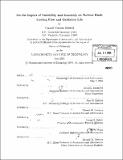| dc.contributor.advisor | David L. Darmofal. | en_US |
| dc.contributor.author | Sidwell, Carroll Vincent, 1972- | en_US |
| dc.contributor.other | Massachusetts Institute of Technology. Dept. of Aeronautics and Astronautics. | en_US |
| dc.date.accessioned | 2005-06-02T18:46:44Z | |
| dc.date.available | 2005-06-02T18:46:44Z | |
| dc.date.copyright | 2004 | en_US |
| dc.date.issued | 2004 | en_US |
| dc.identifier.uri | http://hdl.handle.net/1721.1/17814 | |
| dc.description | Thesis (Ph. D.)--Massachusetts Institute of Technology, Dept. of Aeronautics and Astronautics, 2004. | en_US |
| dc.description | Includes bibliographical references (leaves 77-79). | en_US |
| dc.description.abstract | The life of a turbine blade is dependent on the quantity and temperature of the cooling flow sup- plied to the blade. The focus of this thesis is the impact of variability on blade cooling flow and, subsequently, its impact on oxidation life. A probabilistic analysis is performed on a commercial jet engine to quantify the variability in blade flow and oxidation life due to variability in ambient conditions, main gaspath conditions, the cooling air delivery system, and the flow capability of the blade internal cooling passages. The probabilistic analysis is used to demonstrate that every blade in a turbine row must be individually modeled in order to accurately estimate the distribution of blade-row oxidation life for a population of jet engines. In particular, since the oxidation life of a blade row is limited by the highest temperature (and therefore lowest-flowing) blades, every blade must be individually represented to correctly model (1) the probability of observing (within a row) a blade with a low coolant flow capability, and (2) the flow rate (and therefore the metal temperature and life) of these passages. A simplified flow network model of the cooling air supply system and a row of blades is proposed which agrees qualitatively and quantitatively with the more complex flow network model of the entire jet engine. Using this simplified model, the controlling parameters which affect the distribution of cooling flow in a blade row are identified. Finally, a selective assembly method is proposed to decrease the impact of blade passage manufacturing variability on blade flow. The method classifies blades into groups based on passage flow capability and assembles rows from within the groups. As a result, the flow and the | en_US |
| dc.description.abstract | (cont.) oxidation life improve for the majority of blade rows, while segregating low-flow blades into sets that are no worse than random assembly. Alternatively, selective assembly can be used to allow blades to withstand increased turbine inlet temperature while maintaining the maximum blade metal temperature at random-assembly levels. | en_US |
| dc.description.statementofresponsibility | by Carroll Vincent Sidwell. | en_US |
| dc.format.extent | 79 leaves | en_US |
| dc.format.extent | 4063905 bytes | |
| dc.format.extent | 4070867 bytes | |
| dc.format.mimetype | application/pdf | |
| dc.format.mimetype | application/pdf | |
| dc.language.iso | eng | en_US |
| dc.publisher | Massachusetts Institute of Technology | en_US |
| dc.rights | M.I.T. theses are protected by copyright. They may be viewed from this source for any purpose, but reproduction or distribution in any format is prohibited without written permission. See provided URL for inquiries about permission. | en_US |
| dc.rights.uri | http://dspace.mit.edu/handle/1721.1/7582 | |
| dc.subject | Aeronautics and Astronautics. | en_US |
| dc.title | On the impact of variability and assembly on turbine blade cooling flow and oxidation life | en_US |
| dc.type | Thesis | en_US |
| dc.description.degree | Ph.D. | en_US |
| dc.contributor.department | Massachusetts Institute of Technology. Department of Aeronautics and Astronautics | |
| dc.identifier.oclc | 56557813 | en_US |
